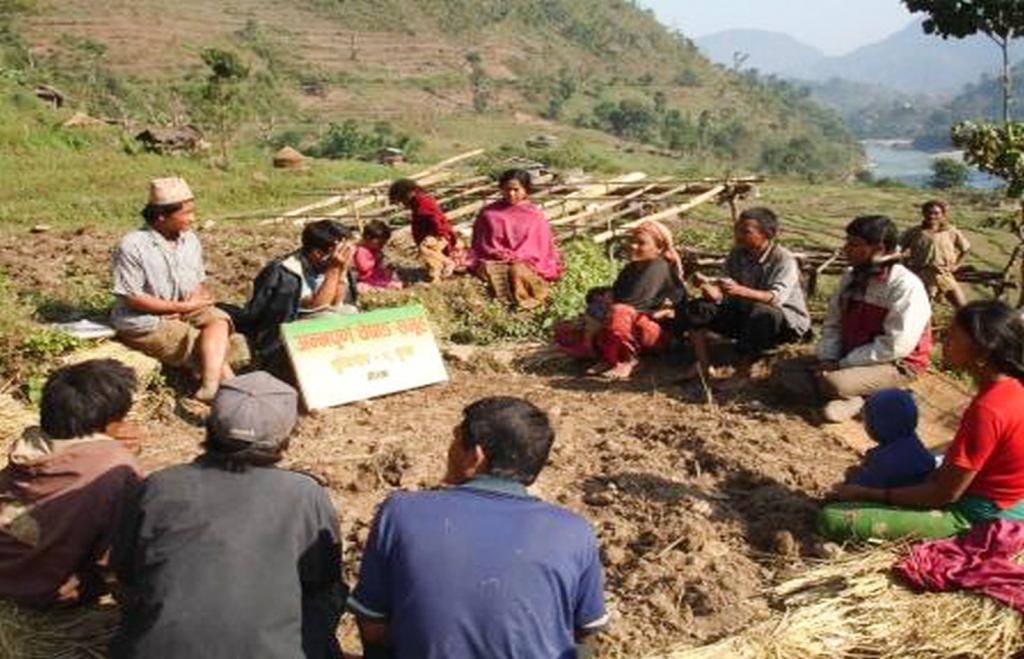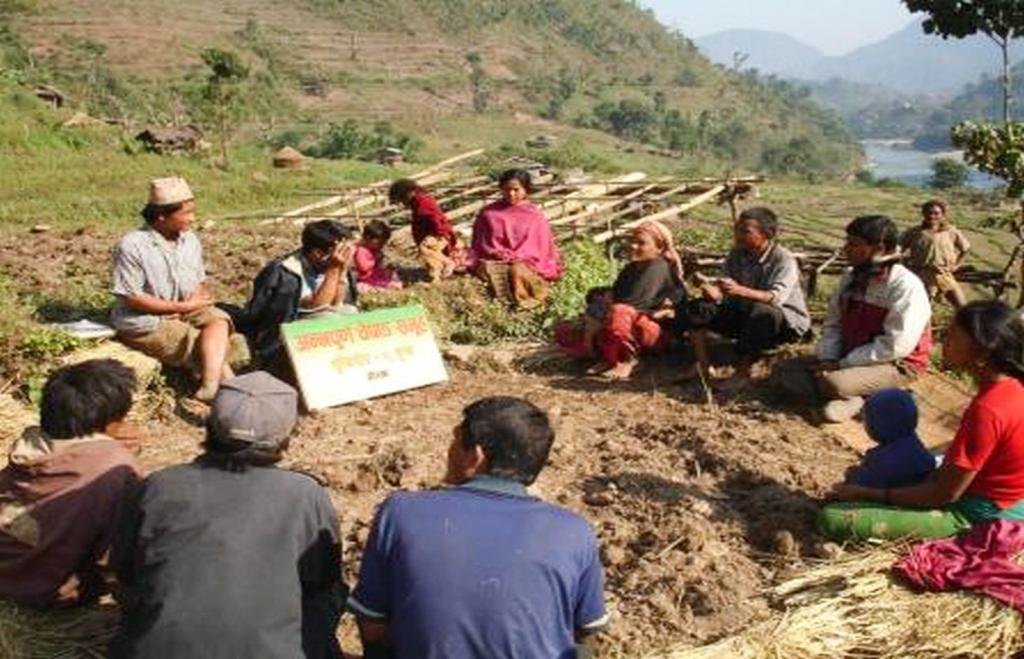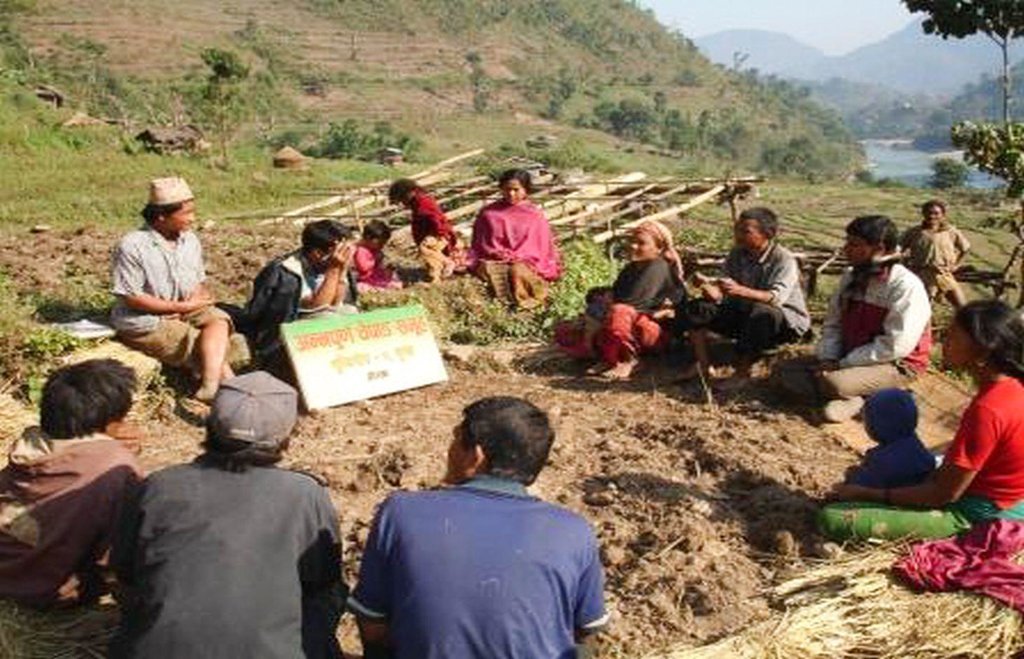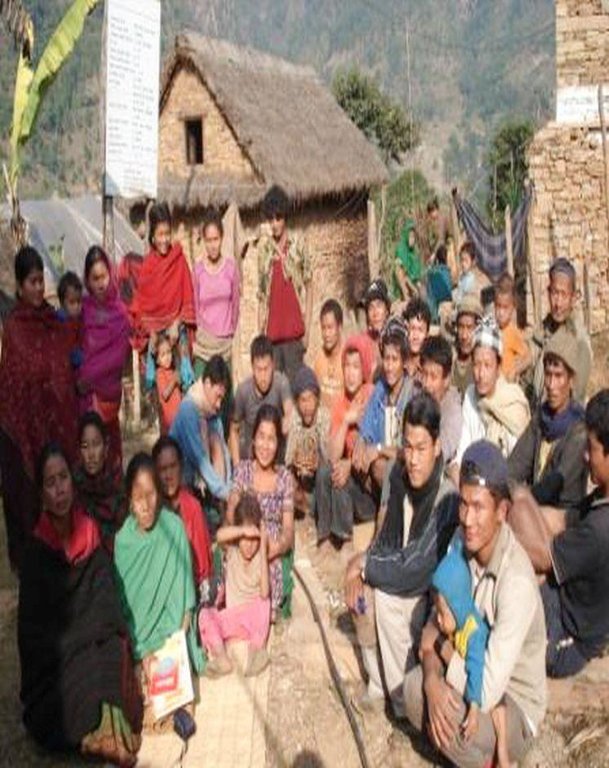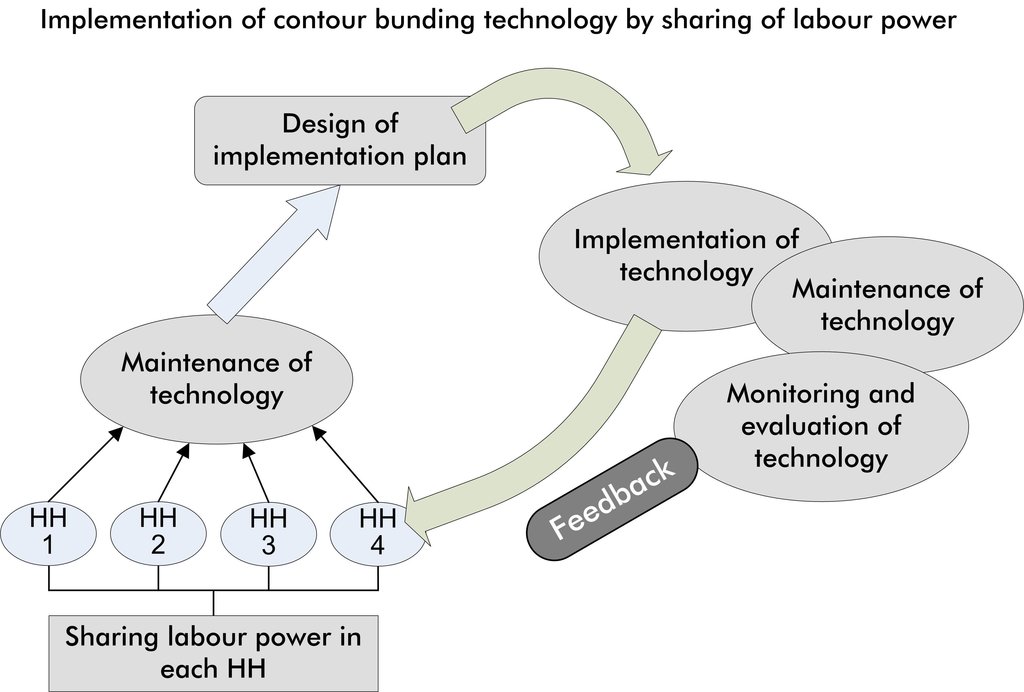Sharing labour to implement contour bunding [尼泊尔]
- 创建:
- 更新:
- 编制者: Shreedip Sigdel
- 编辑者: –
- 审查者: Fabian Ottiger
Janasakti aadanpradhan gari bhajo halne padhiti karanwanan (Main contributor: Bir Bahadur Tamang, LI-BIRD)
approaches_2604 - 尼泊尔
查看章节
全部展开 全部收起1. 一般信息
1.2 参与方法评估和文件编制的资源人员和机构的联系方式
SLM专业人员:
Tamanag Bir Bahadur
+977 61 526834 (0); 9746005992 (M)
btamang@libird.org
LI-BIRD, Gairapatan, Pokhara, P.O. Box 324
尼泊尔
有助于对方法进行记录/评估的机构名称(如相关)
ICIMOD International Centre for Integrated Mountain Development (ICIMOD) - 尼泊尔有助于对方法进行记录/评估的机构名称(如相关)
Local Initiatives for Biodiversity, Research, and Development (LI-BIRD) - 尼泊尔1.3 关于使用通过WOCAT记录的数据的条件
(现场)数据是什么时候汇编的?:
01/03/2013
编制者和关键资源人员接受有关使用通过WOCAT记录数据的条件。:
是
2. SLM方法的描述
2.1 该方法的简要说明
Members of a community can work together to help prevent soil erosion and increase productivity by working collectively to establish contour bunds.
2.2 该方法的详细说明
该方法的详细说明:
Aims / objectives: Over generations, the ethnic minorities of Nepal, who practice fireless shifting cultivation, known as 'gujultyaune', have successfully used contour bunding to control soil erosion, promote water retention, and increase crop production. Contour bunding is a proven sustainable land management practice in areas where the soil productivity of marginal, sloping, and hilly lands is very low. While it is both low cost and simple to implement, it does have the drawback that establishing contour bunds is very labour intensive. When members of a community work together to establish contour bunds the whole village can benefit.
Methods: By working collectively, a community can establish contour bunds that will benefit everyone and not individual farmers alone. The first step is to plan a course of action and to select the sites. Members of the community, who are thoroughly familiar with the landscape that the community inhabits, get together to discuss where the contour bunding will be most successful and benefit the greatest number of farmers. This planning phase is best carried out during the dry season before the rains begin. Once the sites are selected, everyone participates in the slashing of materials on the shifting cultivation lands. After the slashed materials have been allowed to dry for some weeks, the community assembles to gather these into rows that will form the bunds. Every member of the community participates according to their ability.
Stages of implementation: The steps for sharing labour to establish contour bunds in a community which practises shifting cultivation can be summarized as follows:
• The community meets to finalize a plan of action.
• Everyone participates in the slashing of shifting cultivation plots.
• The slashed materials are collected and allowed to dry.
• The slashed materials are formed into rows that will constitute the bunds.
• Everyone participates and eventually, the land between the bunds is prepared for the cultivation of crops.
2.3 该方法的照片
2.5 采用该方法的国家/地区/地点
国家:
尼泊尔
有关地点的进一步说明:
Tanahun, Gorkha District
2.7 方法的类型
- 传统/本土
2.8 该方法的主要目的/目标
The Approach focused mainly on SLM with other activities (increasing crop production)
To increase crop yields and help to prevent soil erosion in communities that practise shifting cultivation by getting the whole community to participate in establishing contour bunds.
The SLM Approach addressed the following problems: The main stumbling blocks to this approach are a gap in the sharing of traditional knowledge, lack of the money needed for investment, community conflicts over allocation of resources, and overall poor social cohesiveness.
2.9 推动或妨碍实施本办法所适用的技术的条件
财务资源和服务的可用性/可得性
- 阻碍
Individual farmers do not have sufficient resources to
implement the technology on their own
Treatment through the SLM Approach: By sharing labour everyone benefits without any outlay by individual farmers
机构设置
- 阻碍
Groups are not aware of how to mobilize for community empowerment
Treatment through the SLM Approach: Raise level of awareness and enhance capacity on how to mobilize the community and on how to institutionalize the process
了解SLM,获得技术支持
- 阻碍
Traditional knowledge on contour bunding is not shared
Treatment through the SLM Approach: Technical information is shared when the technology is implemented
3. 相关利益相关者的参与和角色
3.1 该方法涉及的利益相关者及其职责
- 当地土地使用者/当地社区
This technology is straightforward; the community of land users can implement it without external input. This is a sustainable land management practice in areas where shifting cultivation is practised. These areas have typically been inhabited by poor and marginal groups like the Chepang, Magar, Dalit, and Gurung groups.
3.2 当地土地使用者/当地社区参与该方法的不同阶段
| 当地土地使用者/当地社区的参与 | 指定参与人员并描述活动 | |
|---|---|---|
| 启动/动机 | 自我动员 | Demand created by the community |
| 计划 | 互动 | Through discussions the whole community is involved in deciding what sites are to be contoured and how the bunding technology is to be implemented. |
| 实施 | 自我动员 | The whole community is involved in planning the sites, slashing the biomass, and forming the contour bunds. |
| 监测/评估 | 无 | |
| Research | 无 |
3.3 流程图(如可用)
具体说明:
Each household (HH) contributes labour and the community works together to implement contour bunding.
作者:
AK Thaku
3.4 有关SLM技术选择的决策
具体说明谁有权决定选择要实施的技术:
- 仅限土地使用者(自主)
解释:
The land users themselves decide on the technology during participatory discussions held in the community. This is a bottom-up approach
Decisions on the method of implementing the SLM Technology were made by by land users* alone (self-initiative / bottom-up). The land users themselves possess traditional knowledge on how the technology should be implemented. Since some farmers have a better grasp of the technology than others, the different methods are discussed and the community as a whole decides what method is to be used.
4. 技术支持、能力建设和知识管理
4.1 能力建设/培训
是否为土地使用者/其他利益相关者提供培训?:
是
明确受训人员:
- 土地使用者
培训形式:
- 农民对农民
- 示范区域
- 公开会议
4.2 咨询服务
土地使用者有权使用咨询服务吗?:
是
4.3 机构强化(组织发展)
是否通过这种方法建立或加强了机构?:
- 否
4.4 监测和评估
监测和评估是该方法的一部分吗?:
是
注释:
bio-physical aspects were regular monitored by land users through measurements; indicators: Land users regularly monitor the organic matter and moisture content of the soil and establish plants in bunds
technical aspects were regular monitored by land users through measurements; indicators: Land users regularly monitor terrace formation and soil erosion
socio-cultural aspects were regular monitored by land users through observations; indicators: The community observes and comments on the degree to which contour bunding is implemented
economic / production aspects were regular monitored by land users through measurements; indicators: Land users note crop production and how it affects their cash income
area treated aspects were regular monitored by land users through measurements; indicators: Land users regularly monitor small patches used in shifting cultivation
no. of land users involved aspects were regular monitored by land users through observations; indicators: The whole community participates in observing how many people are involved
management of Approach aspects were regular monitored by land users through measurements; indicators: The whole community participates
There were few changes in the Approach as a result of monitoring and evaluation: Gradually, farmers in other communities are also adopting the same approach
5. 融资和外部物质支持
5.1 该方法中SLM组成部分的年度预算
如果不知道准确的年度预算,请给出一个范围:
- < 2,000
注释(例如主要的资助来源/主要捐助者):
Approach costs were met by the following donors: national non-government (LI-BIRD): 20.0%; local community / land user(s): 80.0%
5.2 为土地使用者提供财政/物质支援
土地使用者是否获得实施该技术的财政/物质支持?:
否
5.4 信用
是否根据SLM活动的方法给予信用值?:
否
6. 影响分析和结论性陈述
6.1 方法的影响
该方法是否帮助土地使用者实施和维护SLM技术?:
- 否
- 是,很少
- 是,中等
- 是,支持力度很大
The approach was a good way of improving sloping land management.
该方法是否有助于社会和经济弱势群体?:
- 否
- 是,很少
- 是,中等
- 是,支持力度很大
Moderate improvements were noted in Chepang, Magar, and Dalit households who benefited from this approach and improved their livelihoods
Did other land users / projects adopt the Approach?
- 否
- 是,很少
- 是,中等
- 是,支持力度很大
Those who implemented this approach cited improved soil fertility and the increased productivity of cash crops like legumes as a plus point.
Did the Approach lead to improved livelihoods / human well-being?
- 否
- 是,很少
- 是,中等
- 是,支持力度很大
these were mainly due to the increased earnings from the production of cash crops. Earnings were invested on daily needs which improved livelihoods.
Did the Approach help to alleviate poverty?
- 否
- 是,很少
- 是,中等
- 是,支持力度很大
Some poverty alleviation was noted among households who could increase the amount that they earned from cash crops. These households used the additional earnings on health care and education.
6.2 土地使用者实施SLM的主要动机
6.3 方法活动的可持续性
土地使用者能否维持通过该方法实施的措施(无外部支持的情况下)?:
- 是
若是,请说明如何维持:
This is a community-based approach; each community formulates its own rules and regulations.
6.4 该方法的长处/优点
| 编制者或其他关键资源人员认为的长处/优势/机会 |
|---|
| Effectiveness (How to sustain/ enhance this strength: Improve the approach by continuing to work together to design, plan, and implement.) |
| Increases social cohesiveness (How to sustain/ enhance this strength: Continue to work collaboratively) |
| Decreased workload (How to sustain/ enhance this strength: Over time, the group decisions that work best no longer need to be revisited and less time is spent in discussions.) |
| Quick implementation of sloping land management measures (How to sustain/ enhance this strength: As the group learns to work together they can taking advantage of their synergy to quickly implement new measures.) |
| Empowerment (How to sustain/ enhance this strength: Encourage the community with technical backstopping) |
6.5 该方法的弱点/缺点以及克服它们的方法
| 编制者或其他关键资源人员认为的弱点/缺点/风险 | 如何克服它们? |
|---|---|
| Some members contribute more than others | Each member of the group needs to be made aware of how they can contribute. |
7. 参考和链接
7.1 方法/信息来源
- 实地考察、实地调查
- 与土地使用者的访谈
7.2 参考可用出版物
标题、作者、年份、ISBN:
Indigenous knowledge of farmers in the shifting cultivation areas of Western Nepal, Regmi, BR; Aryal, KP; Subedi, A; Shrestha, PK; Tamang, BB (2001)
链接和模块
全部展开 全部收起链接
无链接
模块
无模块


